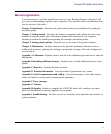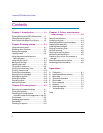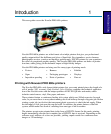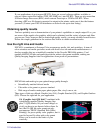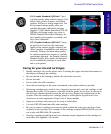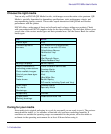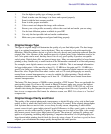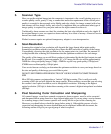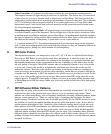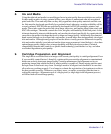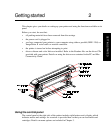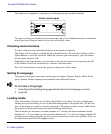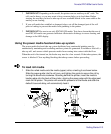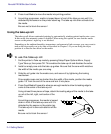
Introduction 1-7
NovaJet PRO 600e User's Guide
INTRODUCTION
3. Scanner Type
How you get the original image into the computer is important to the overall printing process as
scanner quality varies greatly. Using a scanner that meets the requirement of the overall print
quality is essential to have enough color fidelity and edge clarity. An image scanned with a low
end scanner will lose detail, clarity, and color. It is important that you understand what type of
image quality is required for your print and use the right scanner to achieve it.
Traditionally, drum scanners are ideal for retaining the best edge definition and color depth. If
the original image is poor, an expensive drum scan may be a waste of money. Almost all service
bureaus use drum scanners.
Flatbed scanners require an optional transparency adapter to scan transparencies.
4. Scan Resolution
Scanning the original at low resolution will degrade the large-format inkjet print quality.
Scanning at resolution which is too high slows down the RIP and adds no quality to the image.
Consequently, choosing the right resolution for the output print size (and thus, the amount of
scaling needed after scanning) will determine what the optimum resolution is for each image.
The quality of the image you would like to produce is determined by the the final output size and
the file size. For example, if you want output a 36" x 36" image, the file size will be approximately
24MB for a fair-good quality image (75dpi), 43MB for a good-very good quality (100 dpi) and
97MB for an excellent quality (150 dpi) print.
Your service bureau can help you determine the optimum resolution to scan your image based on
the size and quality of the image you would like to print.
DO NOT USE INTERPOLATED RESOLUTION OF YOUR SCANNER TO COMPUTE IMAGE
SIZE
Most 300 dpi scanners can interpolate or “imitate” 600 dpi scanning. This is really not really
scanning at 600 dpi and will degrade the image quality. When scanning, ensure that you are using
the scanner's true optical resolution, not its interpolated resolution. Scanning at the highest
optical resolution (300 dpi) is better than scanning at the scanner's highest interpolated resolution
(600 dpi).
5. Post Scanning Color Correction and Sharpening
All scanned images, even those scanned on expensive drum scanners, must be color corrected
and sharpened before using them for a large-format inkjet print. If you are using a service bureau
for scanning images, their scanner operator will usually do this as part of the scanning fee.
However, you should always check the image before using it. Although the process of color
correction and sharpening are more detailed than can be explained within this document, the
following outline will give you a good grasp of what is required:



